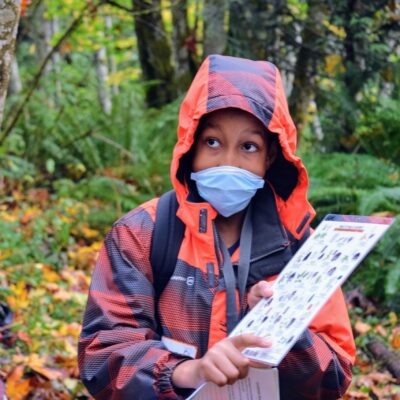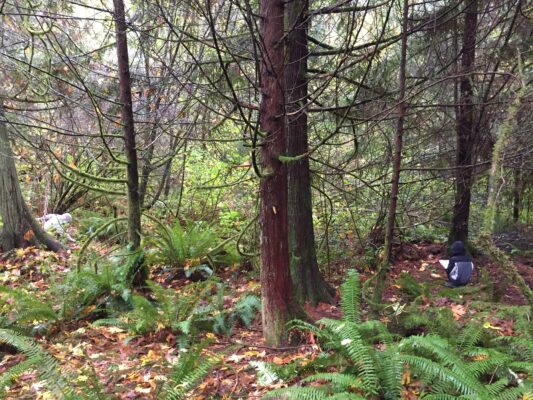Mushrooms and salamanders were catching students’ eyes all day long. A woodpecker fluttered past. Tree frogs were croaking in the distance. Deep in the forest at Grovers Creek Preserve, the rain wasn’t so bad. But these moisture-loving organisms were thriving in the gloomy weather.
That wasn’t exactly what we had come here to study. But that’s the magic that’s possible during Land Labs. We brought out two classrooms from Catalyst Public Schools, one of seventh graders and one of fifth graders, to learn about forests and climate resiliency. Our preserves make great learning laboratories for these students, because they’re full of things for students to observe and learn about. This can be the first seed of a lifelong connection with nature and science.

For this session of Land Labs, students were learning about how to measure the biodiversity of the forest. They made sample plots in the forest of 25’x25’ which they could study. In these areas, students identified tree species and counted them, and they measured the diameter and height of the trees. The whole time, they were in direct contact with the living, vibrant forest – making scientific observations and using them as evidence to support or contradict their hypotheses.
This skill, of quietly observing the world around you, is one of the most important STEM skills that we can give to students. There’s no better place to teach it than out in the field, in a pristine natural environment.

By taking actions to improve biodiversity in our forests, we can make them more resilient to the impacts of climate change. There are many different actions we can take to improve biodiversity – including planting trees, like the students did, or improving habitat for animals, or removing plants that are weakening the forest. In this Land Lab, students had the chance to explore a patch cut and see habitat piles that were made there, and then plant some trees of their own.
In the coming decades, the effects of climate change on our region and our forests will become unmistakable. Already we’re noticing more hot and dry weather in the summers, and heavier rains in the winters. The natural cycles that surround us are out of balance. The resilience of our forests in increasingly extreme conditions will depend on their biodiversity. Look for more blog posts in the coming weeks about actions that we can take to improve climate resilience across our region!

Land Labs gives students the opportunity to start building their relationships with the natural environment. Despite the world-renowned beauty of nature in our region, not everyone has the opportunity to access it or the experience needed to feel comfortable outdoors. This is our invitation to the young people of our region to begin thinking of themselves as part of the natural world, and as possible stewards for it.
Whether it was the mighty trees of the mature forest or the mushrooms and salamanders living beneath their branches, every student found something to connect with at Grovers Creek Preserve. We’re so happy to have the chance to use this preserve as a learning laboratory, and work to pass on stewardship values to the next generation.

This Land Lab was made possible thanks to an Advancing Conservation Excellent grant from the Land Trust Alliance.
